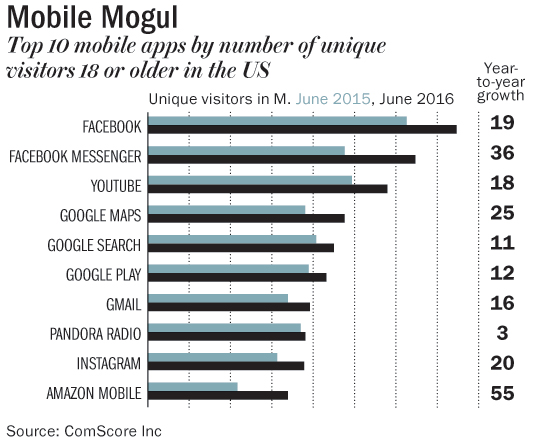Facebook used to be a way to share photos of friends or puppies. Now it’s a news publisher, a broadcaster and a marketplace.
To get an inside view of the company and how it balances these roles, The Wall Street Journal’s Christina Passariello spoke with Facebook’s chief product officer, Chris Cox,and chief operating officer, Sheryl Sandberg. Here are edited excerpts of the conversation:
Balancing act
Passariello: Last week, Facebook said it would relax its rules to allow more newsworthy content to remain on the site. And it decided not to remove some controversial Donald Trump posts. Those sound like editorial decisions. Is Facebook acknowledging it is a media company and not just a technology platform?
Sandberg: Facebook’s the platform for all ideas. It’s core to our mission that people can share what they care about on Facebook. We also want to be a really safe community. You know, there’s no place for violence, terrorism, hate on Facebook. But those things can come into conflict.
I’ll give you an example that’s been recently in the news, the famous Vietnam Terror of War photo. It’s a photo showing the atrocities of war. It’s also a naked child. A naked child violates everyone’s community standards. We took the photo down. On the other hand, this photo has historical significance.
So the decision was made to put that photo back up. What we are saying is that we will make exceptions to our community standards. There could be no better or starker example than child nudity, for the benefit of newsworthiness.
Passariello: Does that make you a news site?
Cox: If you look at how we’ve defined ourselves internally for 12 years now, it has been a technology company. A media company is about the stories that it tells. A technology company is about the tools that it builds. We also realize that we’ve become a significant part of the way a lot of people get information about what’s going on in the world. That comes with a huge responsibility. And it’s one that we take very seriously.
Keeping a close eye
Passariello: With live video and increasing volume of content, are you able to police that content with people? Or do you need more robust technological tools?
Cox: It’s a combination. A lot of the way the system works relies on the community reporting things as they see them. So it’s a combination of building really good tools in every language, on every device, and every place and situation where somebody could use this service to be able to report something that goes against what they feel is a good experience. We’ve worked with experts in the different types of fields where you could have an experience that’s bad. We’ve built teams for each of these areas so that, depending on what’s going on with a person, they can report the person and have it go to a queue. The queue is filled with people who are trained to address those specific types of issues.

The prioritisation of those is related to tools that we’ve built that help assess how bad the situation is based upon what we’ve seen in the past. How urgent is this situation? What is the impact that it’s having on the person? These are both areas where we’re continuing to work on improving the service. But they’re areas where we’ve made big investments and where we have more to do.
Passariello: It seems that people are coming apart politically more than ever. One of our most popular features this year has been Red Feed, Blue Feed, which shows how polarised the political conversation has become on Facebook. You can see how people on different sides of the political perspective are looking at news events differently. Would engagement fall if you showed more of the opposite perspective in the news feed?
Sandberg: Because Facebook enables you to hear more voices in a day than you otherwise would hear, Facebook actually broadens the number and types and diversity of news sources you hear. And so in your news feed every day it’s not just one news outlet. It’s not just five people. It’s a much broader array. People are exposed to more views rather than less.
Edited excerpts from an interview at The Wall Street Journal's WSJDLive 2016 global technology conference.











